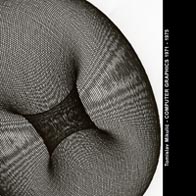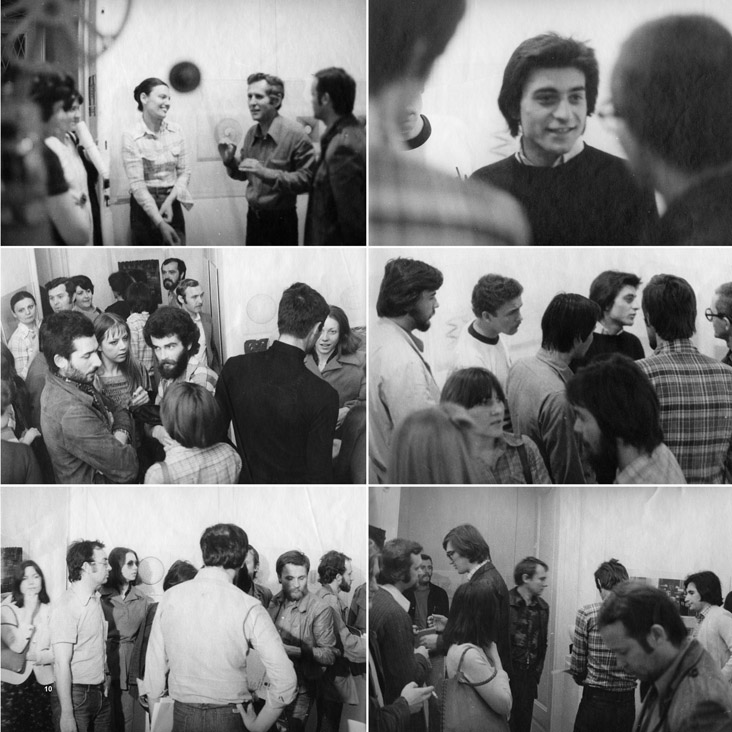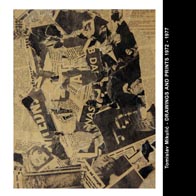1970's
1970, 1971, 1972, 1973, 1974, 1975, 1976, 1977, 1978, 1979
1980's
1980, 1981, 1982, 1983, 1984, 1985, 1986, 1987, 1988, 1989
1990's
1990, 1991, 1992, 1993, 1994, 1995, 1996, 1997, 1998, 1999
2000's
2000, 2001, 2002, 2003, 2004, 2005, 2006, 2007, 2008, 2009
2010's
2010, 2011, 2012, 2013, 2014
CHECK THESE BOOKS IN PDF FORMAT: TM - Computer graphics (13 MB)
TM - Computer graphics (13 MB)
Sony U-matic VO-2630 (2011)
Drawing of Dr. Herbert W. Franke and Tomislav Mikulić (2011)
13. svibnja 1976. god. - Galerija "Nova" Zagreb - Prva samostalna izložba
13 May 1976 - "Nova" Gallery Zagreb - One man exhibition |
||
|
30. obljetnica prvog kompjuterskog animiranog filma u Hrvatskoj 1976. - 2006. Jedne se večeri prije 30 godina okupio priličan broj umjetnika, likovnih kritičara, studenata, novinara, znanaca, rodbine i drugih znatiželjnih ljudi u galeriji “Nova” na otvorenju moje prve samostalne izložbe. Uz kompjuterske grafike i crteže priredio sam projekciju mojih prvih kompjuterskih animiranih filmova. Projekcija je bila kratka i kad se ponovo upalilo svjetlo svi su burno komentirali neobičan doživljaj. Svatko ga je drukčije doživio i komentirao i nitko nije obraćao pažnju na činjenicu da smo tada svi zajedno zapravo bili svjedoci povijesnog prvog koraka u našoj zemlji. Koraka kojim je počeo razvoj te divne iluzije, kompjuterske animacije. Danas možemo s osmjehom na licu usporediti prvu kompjutersku animaciju s onim što svakodnevno gledamo na ekranima. Jednako kao kad bi uspoređivali prvu letjelicu s nekim današnjim mlaznjakom. Razlika u strojevima i tehnologiji koje smo imali onda i koje imamo danas može izgledati groteskno velika generaciji mladih animatora. Ali neki detalji postaju posebno dragocjeni kad ih vidimo iz današnje perspektive iz jedne velike vremenske udaljenosti. Tek sad znamo da su npr. “Morphing” i “Differential frame update” postali komercijalni i popularni tek nakon dvadesetak godina. Da bi mogli prenesti sliku iz ondašnjeg kompjutera na filmsku traku trebalo je rješavati bezbroj tehničkih prepreka. Grafika je bila vektorska za razliku od današnje rasterske. To znači da podaci koji su činili sliku nisu bili dio slike nego jedna vrsta uputa stroju kako graditi sliku. I bez terminala koji je interpretirao brojeve i crtao sliku na zaslonu ti podaci nisu mogli biti nikako drukčije pretvoreni u sliku. Zaslon nije mogao reproducirati boje jer je bio napravljen samo od zelenog fosfora. To je bio dodatni problem jer je crno bijeli film najmanje osjetljiv baš na tu boju. A pojedinačnu ekspoziciju se nije moglo jednostavno produžiti na filmskoj kameri izvan studija. Ipak smo uspjeli dobiti upotrebljivu sliku koja je obrađivana naknadno u laboratoriju. Izradom visokokontrastnih kopija na optičkoj klupi probavali smo filterima I maskiranjem bojati crno bijele slike, ali na taj smo način zapravo gubili fine detalje. Tek je bojanje u video tehnici potpuno uspjelo. U to vrijeme nisu postojali kompjuterski programi za crtanje ili za animiranje. Sve što sam htjeo nacrtati i animirati trebao sam sâm programirati. Najprije su to bili najjednostavniji likovi, kvadrat i krug. Ali da bi se njih oživilo trebalo je koristiti složene matematičke funkcije. Kako su ideje navirale o sve zamršenijim pokretima programiranje mi je postalo najopsežniji ali i najdraži dio posla. S velikim nestrpljenjem sam morao čekati dok film dođe iz laboratorija a svoje sam animacije mogao vidjeti tak nakon nekoliko dana ili čak tjedana. Već nakon 5 - 6 godina ta je tehnologija zastarjela pojavom osobnih računala. Nova generacija kompjutera je potpuno promjenila animaciju. Filmska kamera se prestala koristiti jer je jedino mogla snimati s video ekrana što je bilo neupotrebljivo zbog treperenja i nedostatka oštrine. Još uvijek nije bilo gotovih programa i trebalo je puno programiranja za svaku animaciju. Ali kompjuteri su se sve brže razvijali, počeli su se pojavljivati gotovi programi i tehnička ograničenja su postajala sve manja. Razvoj kompjuterske tehnologije je sve brži i danas smo svjedoci koliko tehnička poboljšanja otvaraju vrata novim vizijama i efektima koji su nekad bili nezamislivi. Zahvalan sam organizatorima ovogodišnjeg Festivala (2006) što su omogućili ovaj kratki izlet vremeplovom u povijest nastanka tog cijelog procesa kod nas. I ponosan sam što sam baš ja kriv za taj početak u ovom dijelu Europe, u svom Zagrebu. Tomislav Mikulić, Akademski slikar grafičar
|
30th Anniversary of the First Computer-Animated Film in Croatia 1976. - 2006. One evening thirty years ago a fair number of artists, art critics, students, journalists, acquaintances, relatives and other interested people came to the Nova Gallery for the opening of my first independent exhibition. Along with computer graphics and drawings, I had arranged a screening of my first computer-animated films. The screening was a short one, and when the lights came up again there was lively discussion of this unusual event. Everyone experienced it and commented on it differently, yet no one took notice of the fact that we had all just witnessed a historic first step in this country, one with which the development of that marvelous illusion, computer animation, had begun. Today it makes us smile when we compare the first computer animations with those we see every day on our screens – just as if we were to compare the first flying machines with today’s jets. The difference between the machines and technology we had then and what we have now might seem grotesquely large to the new generation of animators. Yet certain details seem especially valuable when viewed from today’s perspective, from a great distance in time. Only now do we know that “morphing” and “differential frame update” became commercially viable, and popular, only twenty years later. In order to transfer an image from the computers of that time onto film, an endless amount of technical obstacles had to be overcome. Back then vector graphics were used, rather than today’s raster graphics. This meant that the data composing an image were not part of that image, but rather a kind of instruction to the machine on how to build it. Without a terminal to interpret the numbers and draw the picture on the screen, these data could not otherwise be transformed into an image. The screen could not reproduce colors, as it was made only of green phosphorous. This represented an additional problem, as black-and-white film is least sensitive to precisely this color. And there was no simple way of extending single frame exposure time in a film camera outside the studio. Nonetheless, we succeeded in obtaining a usable image which was subsequently treated in the laboratory. By producing high-contrast copies on an optical printer, we tried to color the black-and-white images using filters and masking, but this led to the loss of fine detail. Only coloring with the use of video technology gave us substantially better results. At that time there were no computer drawing or animation programs. Anything I wanted to draw or animate I had to program myself. At first these were just the simplest figures, squares and circles. But in order to bring them to life, complicated mathematical functions had to be used. As the ideas came to involve more and more intricate movements, programming became the most extensive part of the job, but also the most rewarding. With great impatience I waited for the film to arrive from the laboratory, and could only view my animation several days or even weeks later. After only five or six years this technology had become outdated, due to the arrival of personal computers. The new generation of computers completely transformed animation. The camera was no longer used, since it could only film off the video screen, and this was unusable due to flickering and lack of sharpness. There were still no readymade programs, and each animation required lots of programming. But computers were developing ever more rapidly, readymade programs eventually began to appear, and the technical limitations became smaller and smaller. The evolution of computer technology is constantly accelerating, and today we see to what great extent technical improvements can open the door to new visions and effects which were once inconceivable. I am grateful to the organizers of this year’s festival (2006) for making possible this short trip back through time, into the history of the origins of this whole process in our country. And I am proud to be the one who bears the blame for it in this part of Europe, in my city of Zagreb. Tomislav Mikulić, BFA Painter and graphic artist Translated by Timothy Steyskal |
|



